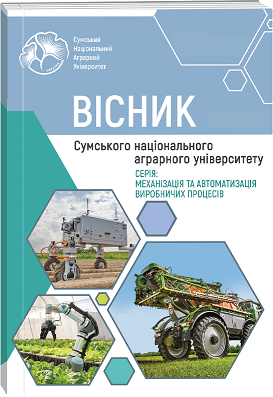DETERMINATION OF THE INFLUENCE OF NETTLE-APPLE PURE ON QUALITY INDICATORS OF YOGURT
Abstract
Yogurt is the most popular fermented milk product on the consumer market. It normalizes the work of the intestines, significantly improves digestion and facilitates the assimilation of nutrients. The use of plant powders and extracts to enrich yogurt with vitamins, minerals and phenolic compounds, which enhance its functional and antioxidant properties, is becoming more and more relevant. The use of compositions of plant origin has the potential to increase and enrich the assortment of fermented milk products with antioxidant properties. The aim of the work is to determine the influence of nettle-apple puree on the quality indicators of yogurt. This will make it possible to develop yogurt technology and expand the range of fermented milk products with increased biological value. Cow’s milk was used as the main raw material, which meets the requirements of DSTU 3662:2018. Pasteurized nettle and apple puree was used as a filler in a ratio of 1:3, 1:5, and 1:15. The filler content (nettle-apple puree) was varied in the recipe of yogurts from 16 % to 20 %. In order to determine the optimal amount of filler, a study of the quality indicators of the studied samples was performed. Standard research methods were used in the work. As a result of the organoleptic evaluation, it was determined that the most attractive and harmonious is sample No. 2 with a nettleapple puree content of 18 %. At the same time, the yogurt is characterized by a creamy-green color with particles of added filler, with a light aroma and a pleasant taste of nettle and hints of apple. The results of physico-chemical and microbiological studies show that the manufactured yogurt samples do not exceed the permissible values according to the standards of DSTU 4343:2004. The results of changes in acidity and the number of microorganisms in yogurts during storage showed that all samples have a smooth tendency to decrease indicators, but within the normal range during 33 days of storage. As a result of the research, the nettle-apple puree ratio is recommended as 1:5, and the amount of filler in the yogurt recipe is 18 %.
References
2. Abdullah, R., Arshad, H., Kaleem, A., Iqtedar, M., Aftab, M., & Saleem, F. (2023). Assessment of angiotensin converting enzyme inhibitory activity and quality attributes of yoghurt enriched with Cinnamomum verum, Elettaria cardamomum, Beta vulgaris and Brassica oleracea. Saudi Journal of Biological Sciences, 30 (2), 103556. doi: 10.1016/j.sjbs. 2023.103556
3. Adriana, D., Georgiana, G. C., Sorina, R., Anca-Mihaela, G., & Lăcrămioara, R. (2018). Assessment of the Antioxidant Activity and Quality Attributes of Yogurt Enhanced with Wild Herbs Extracts. Journal of Food Quality, 18, 5329386. doi: 10.1155/2018/5329386
4. Bajaj-Zhezherun S., & Ilyuk D. (2022). Kharchova tsinnist kropyvy dvodomnoi (Urtica Diodica L.), yak syrovyny dlia vyrobnytstva ozdorovchykh produktiv. [Nutritional value of stinging nettle (Urtica Diodica L.) as a raw material for the production of health products]. Scientific achievements of youth – solving the problems of human nutrition in the 21st century: materials of the 88th International scientific conference of young scientists, graduate students and
students (April–May 2022, Kyiv: NUHT), 1, 41. (in Ukrainian).
5. Goyko, I. Yu., & Stetsenko, N. O. (2022). Doslidzhennia vplyvu fitokompozytsii antyoksydantnoi dii na kompleksnu otsinku yakosti yohurtu [Study of the effect of phytocomposition of antioxidant action on comprehensive assessment of yogurt quality]. Scientific works of the National Technical University of Ukraine, 28 (2), 163–172. (in Ukrainian).
6. Herrera, T., Iriondo-DeHond, M., Ramos Sanz, A., Bautista, A. I., & Miguel, E. (2023). Effect of Wild Strawberry Tree and Hawthorn Extracts Fortification on Functional, Physicochemical, Microbiological, and Sensory Properties of Yogurt. Foods, 12 (18), 3332. doi: 10.3390/foods12183332
7. Kulaitienė, J., Vaitkevičienė, N., & Levickienė, D. (2021). Studies on Proximate Composition, Mineral and Total Phenolic Content of Yogurt Bites Enriched with Different Plant Raw Material. Fermentation, 7, 301. doi: 10.3390/fermentation7040301
8. Najgebauer-Lejko D., Liszka K., Tabaszewska M., & Domagała, J. (2021). Probiotic Yoghurts with Sea Buckthorn, Elderberry, and Sloe Fruit Purees. Molecules, 26, 2345. doi: 10.3390/molecules26082345
9. Ratsuk, M., Yurova, T., & Kazmyrchuk, O. (2023). Otsiniuvannia yakosti ta bezpechnosti yohurtiv z kharchovymy voloknamy [Evaluation of the quality and safety of yogurts with dietary fibers]. Bulletin of the Kherson National Technical University, 1 (84), 107–111. doi: 10.35546/kntu2078-4481.2023.1.13 (in Ukrainian).
10. Samilyk, M., & Demidova, E. (2022). Use of Non-traditional Raw Materials in Yogurt Production Technology. Restaurant and Hotel Consulting. Innovations, 5 (2), 281–291. doi: 10.31866/2616-7468.5.2.2022.270113

 ISSN
ISSN  ISSN
ISSN 



